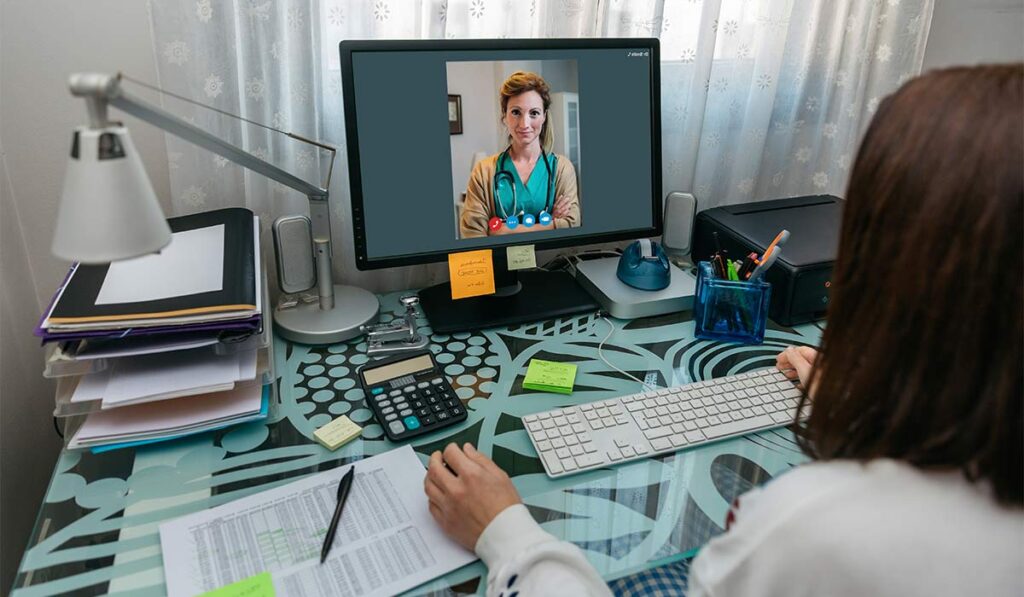Imagine the plight of waiting at the doctor’s office with extreme health issues. The situation gets worse with increasing age. Did you feel good? No, right? Numerous people faced this challenge until telemedicine came to light. With virtual scribes and telemedicine going hand in hand, the health industry has witnessed a revolution in how patients access healthcare.
Long queues and waiting times are not something you look forward to, especially during illness. With your physical and mental strength touching the bottom line, most people prefer talking to a specialist without visiting their offices, which are already flooded with other patients. Telemedicine can be a perfect match for them.
Virtual medical scribes can help to improve telemedicine services, thereby boosting the quality of care delivery. But how? If you are also wondering the same, this blog can be your perfect guide. Before jumping into the main topic, let us have some basic ideas about virtual scribes and telemedicine first.
Understanding Telemedicine
When patients use electronic communication methods to contact a healthcare provider for medical purposes, it is referred to as telemedicine. The wave of digitalization has taken telemedicine to a whole new level, where individuals can consult with a physician without being physically present at their offices. Different types of telemedicine services are teletherapy, teleconsultation, and telemonitoring. This remote care facility is highly beneficial for,
- Elderly adults with mobility issues
- Individuals living in rural or underserved areas
- Patients under critical care
- People suffering from contagious disease
The patients can reach the physician through audio or audio-visual consultations and get digital prescriptions. Although telemedicine existed for a long time, it flourished during the COVID-19 pandemic, outlining the importance of contactless appointments. However, the patient must have access to an electronic mode of communication to avail of this facility.
The Growing Importance Of TeleHealth
Telemedicine is shaping the health industry as telehealth has become a fundamental healthcare aspect in the present time. The post-pandemic era has witnessed a massive inclination towards virtual consultation due to the socialization barriers imposed by lockdown.
Due to the key benefits of telemedicine, a large group of patients have shifted towards it. Online consultation has become an efficient way to address health issues with a physician without having to visit them and wait in a long queue physically. As this is time-saving and more convenient for the patients, telehealth is turning into a regular healthcare norm.
As most of the population has access to electronic communication modes, they are choosing telehealth over physical consultations. The major reasons behind this growing trend are cost-effectiveness and busy schedules. Due to hectic work schedules, the new-age service users have less time to spend in long queues.
Also, physical consultation requires additional expenses, such as travel costs. Therefore, telehealth or telemedicine is becoming highly popular nowadays. In the meantime, telehealth is important for the future of healthcare, too, as it will help provide needful care to patients living in remote locations in the coming days.
The Role Of Virtual Medical Scribes In Telemedicine
The rise of telehealth has made focusing on care delivery gaps essential. With more healthcare providers opening their doors to online consultations, which was a norm during the pandemic, it has become more important to bridge the service delivery gaps to provide quality care. Here is how virtual scribe services can benefit telemedicine providers.
With real-time documentation, a medical virtual scribe updates the electronic health record EHR during live patient encounters. This enables the telemedicine service to bear the most effective outcome. Real-time documentation helps minimize errors as the virtual scribes update the given information simultaneously. The virtual scribe service ensures that telemedicine providers enable positive patient outcomes through updated clinical data.
With the virtual assistance from the scribes, the burden of administrative tasks is drastically reduced. With the freed-up time, healthcare providers can focus more on patient care. The virtual scribes enhance the remote care delivery process, from transcription to post-visit documentation. This administrative support allows telemedicine providers to work more efficiently.
Virtual scribe companies must follow HIPAA (Health Insurance Portability and Accountability Act) standards to provide an ethical documentation service to healthcare professionals. Nonadherence to these guidelines may result in lawsuits from the patient party. As virtual medical scribes bring a higher level of accuracy to the documentation, it enhances the quality of telemedicine delivery and patient outcomes. This accuracy also leads to the elimination of healthcare costs generated from medical errors.
As accurate documentation and administrative support enable telemedicine providers to focus more on patient care, the quality of patient-provider interaction increases. The boosted workplace productivity allows physicians to attend to more patients and critically inquire about their health concerns. Enhanced patient-provider interaction results in accurate diagnosis despite remote consultation and increases the treatment process’s accuracy.
Challenges Of Documentation In Telemedicine
Telehealth is a key area in today’s world. Hence, the challenges associated with telemedicine documentation must be addressed to ensure effective care delivery. Here are some of the common challenges.
At times, the telemedicine platforms do not align with the electronic health records (EHRs), leading to clinical data entry challenges or duplicate entry-related issues. This inaccuracy results in interoperability problems that affect the smooth care delivery process.
Virtual medical scribes are completely dependent on the web, making them vulnerable to connectivity issues. Especially for the telemedicine providers, as the physician, patient, and scribe – all of them are present at different places and connected through the internet. Poor connectivity may affect the entire process.
As all the parties are connected through the web, they individually possess suitable devices that can enable them to connect virtually and result in accurate documentation. Device limitations can create a barrier to quality care. For instance, if the patient does not have a mobile phone or other devices that support an internet connection, then it may become a problem.
Telemedicine providers rely on online consultations, which limits their ability to examine patients physically. Hence, there will be slight differences between the observations. This may impact the scribing services, resulting in documentation gaps. So, the virtual scribes are not directly responsible for this as they completely rely on physicians for accurate clinical data.
As the physicians depend on the information given by the patients, the documentation can go wrong for misreported data. Most of the time, documentation errors are generated for adding wrong symptoms, or medical history. This is more common in telemedicine due to the lack of physical presence of the patient in the exam room, resulting in poor scribing outcomes.
Sometimes, the providers, patients, and scribes do not fall under the same jurisdiction. Hence, the documentation of care should align with that particular region’s regulatory framework. While working with telehealth service providers, maintaining HIPAA compliance during documentation and data storage becomes more complex. All these factors make the job challenging for the virtual scribes.
It is important to follow telemedicine-specific billing codes to ensure higher accuracy in medical billing and coding. However, the system often misunderstands these codes, increasing the number of claim denials and boosting service users’ grievances. These errors can affect the financial backbone of the patients who opt for telemedicine.
How Virtual Scribes Enhance Telemedicine
TeleHealth is one of the key sectors that is enriching the healthcare industry. Here is how virtual medical scribes are transforming the way telemedicine works.
- Accurate Documentation: The real-time documentation enables the virtual scribes to boost the overall accuracy of the medical records. They promptly update the electronic health records (EHRs) to ensure smooth care delivery.
- Burnout Prevention: As virtual scribes provide administrative support and accurate documentation, the number of burned-out health professionals is reduced. As the providers experience a superior quality of mental health, their workplace productivity also increases.
- Enhanced Focus: With the essential scribe services taking care of the documentation, the telemedicine providers can give their full attention to the patients. They can engage more efficiently and learn about the issues in detail. This enhanced interaction leads to accurate diagnosis and better care provision.
- Improved Workflow: With the virtual medical scribes, the workflow becomes more optimized. Real-time documentation enables the scribes to provide on-time EHR updation, preventing delays. Besides managing complex EHR systems, they place orders for lab tests or follow prescriptions to boost the quality of care.
- Risk Mitigation: The medical scribe virtual provides HIPAA-compliant services and follows telemedicine-specific requirements to avoid legal risks, such as costly lawsuits.
- Cost-Effective Practice: As the scribes can support multiple providers sharing the same time zone, multiple 24/7 TeleHealth platforms can benefit. In-house scribes are more costly than remote ones, prompting telemedicine providers to invest in them.
- Quality Data: The scribes use standardized templates most of the time to ensure all the documentation tasks follow a similar format and take less time to finish. Also, they incorporate nuanced patient details, which may have been overlooked during self-documentation.
- Care Continuity: As they encourage post-visit follow-ups, scribes are responsible for better continuity of care.
What Are The Reasons For Outsourcing Medical Scribing For Telemedicine Engagements?
There are plenty of reasons to outsource scribing services rather than hiring in-house staff. Let us look at some key ones.
When the telemedicine providers opt for traditional in-person scribes, they require an office setup which comes with additional cost. Also, they have to be given a salary each month, irrespective of the patient numbers. However, the virtual scribes can be hired during the peak months and do not require any separate setup due to remote working facilities. Hence, they are cost-effective and do not make a hole in the provider’s pocket.
Sometimes, the in-house scribes are not efficient enough and require specialized training to close the skill gap. An outsourced scribe is well-versed in telemedicine scribing and does not require additional training related to expenses. Hence, improved access to skilled labor results in HIPAA-compliant and accurate documentation.
As the telemedicine providers can leave all the documentation-related headaches to the virtual scribes, it saves them a lot of time. With this freed-up time, they can either focus on self-development or they can attend more consultation calls. Therefore, the overall efficiency of the physician increases with a skilled and outsourced scribe.
When the providers outsource a remote scribe from the major virtual medical scribe companies, they get strong administrative support and are well-versed in critical terminologies and telemedicine-related facts. This knowledge enables them to minimize errors and bring a higher level of accuracy in the medical records.
Outsourcing allows healthcare providers to adjust their scribe numbers based on the patient inflow. During the peak season, the clinicians can opt for multiple scribes to support them with the back-to-back documentation. This is highly beneficial for the busy telemedicine provider platforms. It helps them to tackle the bulk number of patients coming through their 24/7 available service.
As the telemedicine providers can get optimum help from the virtual scribes, their workload drastically decreases. With the freed-up time, they can get back to their personal lives and mental well-being. Quality mental health enables them to prevent workplace burnout and become more productive. Their well-being is directly connected to positive patient outcomes.
Why TeleScribes Is Right For You?
A telemedicine scribe or TeleScribe refers to a remote medical scribe who assists the telemedicine providers in focusing more on patient care by taking up administrative tasks. If you are a TeleHealth service provider, it is common for you to feel burdened under the extreme pressure of an administrative workload that does not involve direct care provision.
A TeleScribe can help you maintain a healthy work-life balance by reducing this workload. They are well-versed in the relevant regulatory frameworks and telemedicine-related facts that help physicians bring out the optimum level of outcomes for patients. As they work remotely, investing in extra workspace is unnecessary.
This helps to minimize certain costs related to setup and electricity. As the patients are not physically present at the telemedicine provider’s office, the scribes are also not required to be present in the exam room. They can provide remote service, allowing them to work at odd hours, depending on emergency patient encounters.
How TeleScribes Work?
A human TeleScribe listens to the online patient consultation and provides real-time data in the medical records. They can use either audio or video to transcribe the data in the electronic health record systems for better continuity of care. Real-time documentation helps to minimize errors and navigate the treatment in the right direction without interrupting the consultation flow.
The highly-trained scribes are fluent in complex medical terminologies and slang related to telemedicine. This boosts work efficiency as they understand critical terms and produce accurate documentation. At times, remote medical scribes lean towards technological advancements to minimize unwanted errors.
Tools like advanced transcription software, speech recognition systems, etc., help virtual medical scribes assist telemedicine providers efficiently. Frequent quality checks are essential for making sure that the scribing service is HIPAA-compliant and is going in the right direction. These are essential for the TeleScribes to maintain data security and prevent unauthorized third-party access.
ScribeMedics: Your Partner In Telemedicine Documentation
TeleHealth has become a key mode to make sure that patients from underserved or remote areas are not deprived of necessary healthcare services. Virtual medical scribes enable telemedicine providers to focus on patient outcomes rather than administrative workload. It is important to ensure effective telemedicine documentation so that the patients get accurate care.
ScribeMedics, one of the best virtual scribe companies, provides superior quality services. It enables telemedicine providers to ensure positive patient outcomes. Their virtual scribe services are focused on reducing the providers’ workload. It boosts their productivity and makes them capable of handling more patients.
ScribeMedics can help physicians provide better telemedicine services through HIPAA-compliant documentation. Their remote medical scribes are well-versed in telemedicine-related documentation facts that enable them to efficiently update the electronic health records (EHRs) to maintain continuity of care without any interruption.
Conclusion
Telemedicine has brought a revolution in the way individuals get access to care. With the easily accessible mode of online consultation, the patients can choose to skip the long queues at the healthcare facilities while receiving accurate health solutions. However, telemedicine services come with their own challenges. With efficient virtual scribing solutions, these gaps can be closed.
They work remotely, reducing the overall budget of the providers required for an office setup or electricity bills. A virtual medical scribe provides error-free and HIPAA-compliant documentation so that healthcare professionals can deliver the most efficient care. TeleScribes updates the electronic health records seamlessly for a better continuity of care.
In this digital world, where most healthcare operations have adopted the virtual mode, it is important to incorporate needful practices to enhance operational efficiency. Besides the tech-savvy new-age service users, the older generations also lean towards telemedicine for their optimum convenience. With ScribeMedics, the health industry is expected to witness an upward direction in EHR management and positive patient outcomes.
Conclusion
The scribing companies help the healthcare providers with administrative assistance. Unlike the traditional in-house scribes, a virtual medical scribe helps physicians with documentation without being physically present in the exam room. They provide real-time documentation that minimizes errors and helps providers improve care delivery quality.
A virtual scribe plays a key role in streamlining telehealth services. With the surge in telemedicine, it has become essential for providers to upgrade their operations to align with this healthcare service trend. Especially since the pandemic, the demand for telemedicine providers has exponentially increased. Virtual scribes provide accurate documentation to improve telehealth service outcomes. ScribeMedics can offer high-quality virtual scribe services to its clients
When healthcare providers treat patients based on the medical information shared via telecommunications instead of through a physical consultation in the exam room, it is called telemedicine. It helps them to provide remote care to patients from underserved areas who do not have proper access to healthcare services. Even if the patient has no doctor’s office available near their location, they can get immediate access to a physician via online consultation. Telemedicine providers rely on electronic devices and the internet to ensure that service users get the necessary medical intervention.
Telemedicine helps increase access to care and allows providers to reach the farthest corners of the world without crossing any borders. It is beneficial for both the patient and the doctor. While the patients can surpass travel costs and prolonged waiting time, the physicians can provide needful care to more patients. With reduced physical interaction, contagious diseases can be effectively contained, reducing the overall healthcare burden. Elderly patients with mobility issues especially benefit from telemedicine.
Positive patient outcomes depend on efficient interaction between the clinician and service user. Irrespective of the communication mode, scribing solutions are integral to ensure an updated electronic health record system without pushing the care providers toward burnout. When the patients opt for online consultations, it becomes more integral to focus on the documentation as there is no scope for physical examination that can provide a solid base for the clinician’s observation.
Telemedicine providers rely on patient-provided information to develop an intervention plan addressing the health concern. However, the effective combination of virtual scribes and telemedicine enables physicians to deliver optimum quality of care. Hence, medical scribing in telehealth is all about paying close attention to the conversation, promptly picking up the cues, and clarifying any ambiguity post-visit. All these steps can ensure error-free documentation that complies with HIPAA standards.
After the lockdown, it has become evident that the healthcare sector cannot stop operations, even if the other industries do. This can highlight the grave importance of the overall well-being of healthcare professionals. If they are mentally or physically unwell, they can no longer provide quality care to the patients. Physicians who are burdened with documentation tasks are too exhausted to focus on patients. The teamwork between virtual scribes and telemedicine providers can reduce this extreme workload and allow clinicians some spare time.
With this freed-up time, the physicians can focus on self-development to provide better quality care. They can also attend to more patients and reduce healthcare burden. In addition to this, physicians can maintain a healthy work-life balance, allowing them to be more productive at work. Also, virtual scribes are cost-effective, which helps the telemedicine providers to stay within their budget limit.
Telehealth has become a growing trend that helps millions of patients from underserved areas or with mobility issues to access care. Telemedicine providers have opened their doors to online consultations to blend in and support the massive number of customers looking for it. The importance of this service has been better understood after the COVID-19 pandemic. As the people were forced to stay indoors to contain the spread, they opted for online physician consultations. Telemedicine scribing needs optimum focus as all the parties are at different locations and are connected to serve a single purpose.
Virtual scribes and telemedicine are closely related, as highly-trained scribes can ensure proper documentation without observing visual cues. ScribeMedics offers the best virtual scribes for physicians to streamline the remote care delivery process through efficient documentation. They help to reduce the administrative burden without affecting the flow of interaction. This scribing platform enables healthcare professionals to focus on patient outcomes and keep burnout at bay.
Remote care refers to providing needful clinical care to the patient through digital communication. There is no physical examination, and the physicians instruct the patient to follow the intervention. In virtual care, the patient takes charge of their own health with direct instructions from the clinician. This service also involves non-medical tasks, such as post-treatment health monitoring like BP checks.
In telemedicine, the patient opts for online consultation to avoid visiting the doctor’s office. Only an efficient telemedicine practitioner can enable positive patient outcomes. Hence, the recovery largely depends on this specialized skill. Telehealth has both remote care and telemedicine under its wings. Besides clinical consultations, this segment also involves EHR management or patient education.
Scribing solutions turns out to be one of the key ways to reduce the number of burned-out health professionals. It is known that electronic medical records are of great importance in providing quality care, and it is important to minimize documentation errors. This is more common during self-documentation as the physicians are already exhausted with the back-to-back consultations. The combined efforts of virtual scribes and telemedicine providers are integral to ensuring the overall health and wellness of the service users.
The scribes make sure all the clinical data shared during the consultation and observations made by the provider are efficiently added to the EHRs. As the clinicians rely on patient-provided data, it is the same for the virtual scribes, too. Hence, the accuracy of the documentation is based mainly on the correctness of the given data. The scribes cross-check with the physicians to clear any ambiguity and prevent documentation errors caused by misinterpreted data.
A virtual medical scribe aims to streamline the documentation and provide administrative support to the physicians. This fosters a healthy work-life balance and prevents clinician burnout. With fewer administrative tasks, clinicians become more productive at work. With improved mental and physical well-being, medical errors are drastically minimized. Hence, virtual scribes work tirelessly to ensure accurate documentation.
While the in-house transcriptionists are available for a limited time, the flexible work hours of virtual scribes make them a more appealing choice among clinicians dealing with extreme workloads. Major telemedicine companies prefer scribes who can work simultaneously to manage the increased patient inflow. Remote medical scribes can be available 24*7 to ensure accurate documentation whenever necessary.
Although telemedicine services are completely legal in the United States, they follow several complex regulatory guidelines. These are a combination of both stage and federal regulations. Health Insurance Portability and Accountability Act (HIPAA) is a key regulation to follow, especially for the documentation process. It helps to maintain a higher quality of clinical data in the EHRs. As for the Ryan Haight Act, the mandated in-person visit before prescribing drugs was excluded during the COVID-19 pandemic.
The reimbursement facility of Medicare and Medicaid took a turn during the lockdown as the remote care costs were also being covered at that time. This is extended afterward and is on the verge of becoming a permanent step. Telemedicine software and tools follow FDA regulations. As for the state laws, licensure and prescribing laws are followed by the telemedicine providers. While some states impose regulations stricter than HIPAA, most of them require informed consent before proceeding. Under parity laws, some states eliminate the reimbursement difference between in-person care and telemedicine.
If you are a licensed telemedicine provider, you are eligible to provide needful care. However, as for the eligibility of the patient, there are no such complex laws. After the pandemic, telemedicine has become normalized. There are state-specific provisions that are needed to be followed. Some states do not allow telemedicine service for medicine related to abortion. Meanwhile, some states prohibit non-controlled substances under the approved prescribed drug lists. Therefore, individuals looking for health consultations based on these are not eligible in the respective states.
At times, the services are limited to patients living in remote or underserved areas. This practice helps to maintain a balance and ensures those who are capable can visit the doctor’s office for physical examinations. Hence, to become eligible, you should have access to electronic devices. Insurance coverage is another key aspect of eligibility.
Dinesh Kumar is a healthcare workflow architect and clinical documentation expert with over a decade of real-world experience supporting physicians across multiple specialties in the United States. As the Co-Founder of ScribeMedics, he has helped transform how medical practices handle documentation, coding, and administrative workflows, reducing burnout, improving patient flow, and enabling clinicians to reclaim their day.
Since 2013, Dinesh has worked closely with providers on the front lines of patient care. Over the years, he witnessed a recurring problem: clinicians were drowning in administrative work, spending hours after clinic hours updating charts, reconciling notes, and managing documentation backlogs. Instead of accepting this as “part of the system,” he decided to fix it.
Under his leadership, ScribeMedics has grown into a global hybrid scribing and documentation support company known for accuracy, compliance, and reliable workflows. From medical scribes and CPC-certified coders to virtual back-office support, his teams help multispecialty practices increase revenue integrity, reduce charting time, and improve patient-physician satisfaction.
Dinesh works with healthcare providers, practice owners, and attorneys who want streamlined documentation, better reimbursement outcomes, and more efficient operations. His approach blends empathy, process engineering, and deep domain expertise to create systems that work, day after day.
When he isn’t optimizing clinical workflows, Dinesh mentors documentation teams, trains young professionals, and speaks about burnout prevention, workflow design, and the future of hybrid AI-driven scribing.









 Medical Transcription
Medical Transcription Medical Billing
Medical Billing Medical Coding
Medical Coding